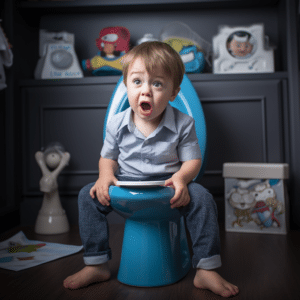Potty Training Success: A Journey of Patience and Consistency
Potty training your baby can be a journey of ups and downs. With the right approach, you can teach them this essential life skill. Develop a routine and create a positive atmosphere. Consistency is vital.
Introduce the toilet concept at 18-24 months. Have regular bathroom breaks. Reward success and don’t punish accidents. Get your baby involved by letting them pick potty chairs or training pants. Read books or watch videos about potty training to help them understand.
One parent, Emily, potty trained their daughter. They put a small potty chair in the bathroom and asked her to sit on it before bath time. There were errors, but they stayed patient and provided support. After a few weeks, Emily learned to use the toilet independently.
Understanding the readiness signs

Is your baby ready for potty training? Look for these signs:
- Consistent bowel movements.
- Showing interest in the toilet.
- Able to communicate their bodily needs.
These signs will help make the transition easier. Every child develops at their own pace, so be patient and supportive. Create a positive environment around the toilet. Provide a comfortable potty chair or seat insert and praise them. Accidents may happen, but with guidance, they’ll learn good habits.
Schedule consistent bathroom breaks to build a routine.
Preparing for potty training
- Set up a routine: Pick certain times of the day for potty breaks. This will help your baby understand when it’s time to use the toilet and learn consistency.
- Create a comfy area: Make sure your baby feels safe in the bathroom. Get a special potty chair or seat insert that fits their size and age. Decorate the space with their favorite toys or books to make it inviting.
- Teach proper hygiene: Show your baby how to wipe, flush, and wash after using the toilet. Demonstrate these steps and encourage them to imitate you. This will help build healthy habits.
- Use positive reinforcement: Congratulate your baby with praise, stickers, or small treats when they use the potty. Celebrate their successes to motivate them and boost their self-confidence.
- Be patient and consistent: Potty training may take some time, so be prepared for setbacks. Remain patient and consistent throughout the process.
Every child is different, so adjust these methods to your baby’s needs and progress. Also, watch for potty training readiness signs, like staying dry for long periods, taking interest in others using the potty, or showing unease in wet diapers.
Finally, according to Dr. Chris van Tulleken from BBC.co.uk, babies exposed to open-air nappies can learn bladder control faster than those who wear closed diapers during waking hours.
Starting the potty training process
- Introduce the potty concept to baby. Show them what it is used for and explain it in simple terms.
- Establish a routine, like after meals or naps, so they have chances to practice.
- Teach baby words or signs to indicate needs.
- Praise and reward successes.
Remember each child progresses differently. Patience and consistency are key.
The American Academy of Pediatrics suggests not starting too early, as this can extend training periods. Wait until baby shows signs of readiness, like staying dry longer or showing interest in others’ bathroom habits.
(Source: The American Academy of Pediatrics).
Maintaining consistency and patience
Consistency is key in potty training. Stick to the same routine every day, so your baby knows when to use the toilet. Speak simply and explain clearly.
Patience is vital. Accidents are normal, so don’t get mad. Praise and reward successes.
Use a visual aid to help your baby understand the concept. It can be a chart or diagram of each step.
Pro Tip: Be consistent but also flexible. Every child is different, so adjust your strategy for their needs and progress. Patience, consistency, and understanding will help you succeed.
Graduating from diapers to underwear
As your baby grows, it’s time to transition them from diapers to undies. It’s a major milestone in their development and independence. Patience and consistency are key when guiding your toddler through this change. Here’s a 5-step guide to help you out:
- Explain the purpose of undies. Use positive reinforcement and let them know it means they’re becoming a “big kid.”
- Choose the right time. Look for signs that they’re ready; such as interest in the toilet or staying dry for longer.
- Get the right tools. Have a potty chair or toddler-sized seat ready, and let them pick fun and colorful undies.
- Create a schedule. Regular bathroom visits throughout the day, like after meals and before bedtime. Encourage them to sit on the potty and praise them for their progress.
- Celebrate successes and be patient. Accidents are normal, so stay calm and provide gentle reminders.
Historically, potty training has been around for centuries. Ancient Egyptian carvings and murals depict it. The goal is the same now as it was then: helping our kids be independent in this life skill. So, take heart in knowing you are part of a long-standing tradition!
Troubleshooting common potty training challenges

Accidents? Don’t panic – it’s normal. Show a positive attitude and no frustration. Encourage your child to use the toilet and praise successful attempts.
Resistance? Make potty training fun with colorful potties or reward charts. Let your child choose their own underwear to get excited about transitioning.
Fear or anxiety? Create a calm environment during bathroom visits. Reassure your child that it’s safe and normal to use the toilet. Encourage and comfort them.
Night-time training? Limit liquids, establish a routine and consider using absorbent bed mats or training pants.
Regression? Stay consistent with your approach. Offer support and remind your child of successful experiences. Patience and understanding will pave the way.
Don’t compare your child’s progress with others. Every child develops differently. Stories like my friend’s daughter, who embraced the toilet with patience and perseverance, offer reassurance.
Potty training challenges? Creativity, adaptability and understanding your child’s needs is key. Embrace this phase as an opportunity for growth and learning.
Final tips and reminders
Consistency is key! To instill a routine, take your baby on regular bathroom trips. Praise and reward them when they do well; small treats or words of encouragement work. Patience is necessary: potty training takes time and accidents might happen. Clothing choice is important too: pick items that are easy to take off. To avoid accidents at night, limit fluid intake before bedtime and ensure they use the bathroom before bed. Trust their cues when they need to go and guide them towards the potty.
Each child is different, so adapt these tips to suit your baby. A positive environment, consistency and patience will help your little one through their potty training journey. Accidents may still occur – simply redirect them to the bathroom calmly and remind them of proper toilet usage. To make it fun, use stickers or let them choose their own special underwear. With time and dedication, you’ll be celebrating their achievements soon!
Conclusion
Consistency and communication are key when it comes to potty training. Use simple language and reward successes with stickers or treats. Offer your baby comfortable underwear or training pants for a sense of independence. Cleaning supplies are essential for accidents. Avoid punishment or shaming. Provide a potty chair or adapter seat and make bathroom time fun with books or games. Be patient and celebrate progress. These are the key points to a successful journey towards diaper independence.
Frequently Asked Questions
1. When should I start potty training my baby?
It is recommended to start potty training when your baby is between 18 to 24 months old. However, every child is different, so look for signs of readiness such as showing interest in the toilet or staying dry for longer periods.
2. How do I know if my baby is ready for potty training?
Some signs that indicate your baby is ready for potty training include staying dry for a couple of hours, showing discomfort in a dirty diaper, or expressing interest in the bathroom or toilet activities.
3. What are some effective potty training methods?
There are several potty training methods, such as the “child-oriented approach” where you let your baby take the lead, or the “timer method” where you schedule potty breaks. Choose a method that suits your child’s temperament and be patient throughout the process.
4. How long does potty training usually take?
The duration of potty training varies for each child. It can take anywhere from a few weeks to several months. It is crucial to be patient, consistent, and provide positive reinforcement during the training process.
5. Should I use rewards or incentives during potty training?
A reward system can be an effective tool during potty training. Small rewards like stickers or praise can motivate your baby and make the process more enjoyable. However, avoid making rewards the sole focus and emphasize the benefits of using the potty instead.
6. What should I do if my baby has accidents during potty training?
Accidents are a common part of the potty training process. Stay calm and encourage your baby to use the potty next time. Avoid punishment or shaming, as it can hinder their progress. Instead, offer support, remind them to use the potty, and clean up accidents cheerfully.





